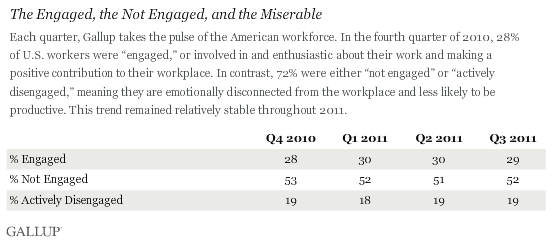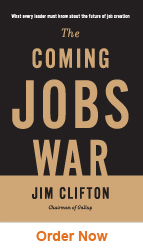There are currently more than 6 million companies operating in the United States. Within these workplaces is the will to create the next 20 million businesses. Many startups are incubating within these existing organizations. They will manifest themselves either when "intrapreneurs" [who work inside companies and are the brains and energy behind creating customers] create new business models in their own companies or when entrepreneurs venture out and start new firms of their own. America needs both. Every city in the world needs both.
For all you Six Sigma enthusiasts, a miserable employee, particularly a miserable manager, is a defect.
Let me summarize the biggest body of behavioral economic data in the world on workplaces. It comes from a Gallup study on workplace productivity, and it consists of 12 critical elements of work life. Gallup has asked millions of workers worldwide to respond to these items for more than a decade and always finds the same thing: Miserable employees create miserable customers.
That may seem obvious, but try to find solid metrics in any organization that clearly link employee misery to customer outcomes by individual work unit. Every company has solid-gold data for sales and profit or product defects, but few know their misery quotient by workgroup.
And if you can't find the misery quotient, I guarantee your accounting department will. It will take a year or two though. I've observed that employee misery precedes all the easy-to-find data by one day to two years, depending on the type of business. Somebody in the company needs to treat a customer like hell for between one day and two years before the customer will defect. Customer defections are immediately followed by job loss.
But as I said before, few companies know their misery quotient. And not nearly enough organizations in the world have the metrics on the intricate behavioral economic wiring between customer and employee by work unit. This information is rare because leaders are drawn to all the wrong metrics, so they pay attention to all the wrong things -- they ask employees questions about compensation, benefits, vacations, parking, and the cafeteria. Virtually all employee surveys lack statistical correlations to sales increase and subsequent job creation because they ask the wrong questions -- directing leaders to work on the wrong things.
Defective employees
For all you Six Sigma enthusiasts, a miserable employee, particularly a miserable manager, is a defect -- a defect for the company, the customer, and ultimately the country. Gallup counted the number of extremely miserable employees -- which we refer to as "actively disengaged" because they also encourage others to be disengaged -- right at 20 million nationwide. Out of approximately 100 million full-time workers, there are 20 million actively disengaged employees in the United States.
Re-winning the world's best jobs is part of winning the innovation and entrepreneurial wars. And as America wins those, initially it will be manufacturing its own inventions, at which the country will temporarily be the best in the world. But shortly thereafter, far cheaper labor in other countries is likely to take that over.
That is OK, as long as the United States incorporates the invention, creates the almighty business model, and owns and operates it around the world. This simple U.S. world trade and economic strategy works in many productive ways now (think iPod). This whole premise depends on Americans' ability to be innovators, to be entrepreneurs, and especially to create world-class business models to ignite authentic GDP growth and job creation.
Low-energy workplaces, or as Gallup calls them, disengaged workplaces, will derail that.
Where is the United States on the behavioral economic standard of miserable vs. engaged employees? Right now, as I mentioned earlier, the country has just over 100 million employed people in real full-time jobs. Gallup has determined that 28% of the American workforce is "engaged," another 53% is "not engaged," and a staggering 19% is "actively disengaged." (See graphic "The Engaged, the Not Engaged, and the Miserable.")

The 53% of not engaged workers are not hostile or disruptive, and they are not troublemakers. They are just there, killing time with little or no concern about customers, productivity, profitability, waste, safety, mission and purpose of the teams, or developing customers. They're thinking about lunch or their next break. They are essentially "checked out." Most importantly, these people are not just part of your support staff or sales team. They are also sitting on your executive committee.
Engaged employees are the creative force behind everything good that happens in an organization.
And then there are the 19% of actively disengaged employees who are there to dismantle and destroy your company. They exhaust managers, they have more on-the-job accidents and cause more quality defects, they contribute to "shrinkage" -- as theft is politely called, they are sicker, they miss more days, and they quit at a higher rate than engaged employees do. Whatever the engaged do, the actively disengaged seek to undo, and that includes problem solving, innovation, and creating new customers. When you're in a meeting with nine other people, odds are that two of them are taking notes to make damn sure whatever you're planning doesn't see the light of day.
The 28% of engaged employees are the best colleagues. They cooperate to build an organization, institution, or agency. They are the creative force behind everything good that happens in an organization. They are the only people in your organization who create new customers.
The explosion of entrepreneurship that GDP growth requires won't happen until the country doubles the number of its engaged employees -- just doubles it, especially in the sweet spot of job-creating small and medium-sized businesses, but really in every company. If companies double their number of engaged employees, they'll double the number of ideas and commercial energy running through the national grid of interconnected workplaces. If that happens, America will grow the best jobs in the world.
12 frames of mind
For more than 75 years, Gallup has counted, sorted, and analyzed every state of mind imaginable in the workplace. And we found 12 behavioral economic-based standards -- 12 frames of minds -- to which virtually all performance outcomes can be attributed. We didn't find 45 or 80, but 12, all separate and distinct from one another.
Gallup also found that other apparent key variables (such as "I'm fairly compensated") outside the 12 didn't distinguish between engaged and disengaged employees. These 12 items hold up statistically throughout all job variations and throughout business and industry, retail, hospitality, manufacturing, government, nongovernmental organizations (NGOs), the military, education -- virtually all jobs everywhere in the world.
Employees' responses to the 12 survey items neatly factor all workers into the three categories of engaged, not engaged, and actively disengaged. These items are:
Q01. I know what is expected of me at work.
Q02. I have the materials and equipment I need to do my work right.
Q03. At work, I have the opportunity to do what I do best every day.
Q04. In the last seven days, I have received recognition or praise for doing good work.
Q05. My supervisor, or someone at work, seems to care about me as a person.
Q06. There is someone at work who encourages my development.
Q07. At work, my opinions seem to count.
Q08. The mission or purpose of my organization makes me feel my job is important.
Q09. My associates or fellow employees are committed to doing quality work.
Q10. I have a best friend at work.
Q11. In the last six months, someone at work has talked to me about my progress.
Q12. This last year, I have had opportunities at work to learn and grow.
A great manager has employees who score all 12 of these items as highly as possible; the items are measured on a 1-5 scale of agreement, with 5 being highest (or "strongly agree"). All innovation, entrepreneurship, authentic sales growth, new customers, job growth -- all the things that every company needs most -- are sparked and inspired by the relationships between managers and employees that these 12 items measure.
As I said before, if twice as many American workers scored high on these 12 frames of mind every day, that would create sudden significant change; it would generate more rapid job growth than anything else. Going from 30 million engaged workers to 60 million engaged workers would change the face of America more than any leadership institution, trillions of stimulus dollars, or any law or policy imaginable.
Raising the percentage of America's engaged employees from 28% to 60% would double innovation and double entrepreneurship. It would create the conditions necessary to suddenly overwhelm competing nations because engagement creates new customers.
